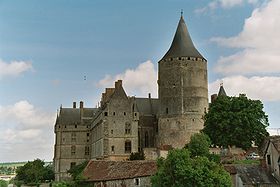
Château de Châteaudun
Encyclopedia

Castle
A castle is a type of fortified structure built in Europe and the Middle East during the Middle Ages by European nobility. Scholars debate the scope of the word castle, but usually consider it to be the private fortified residence of a lord or noble...
located in the town of Châteaudun
Châteaudun
Châteaudun is a commune in the Eure-et-Loir department in northern France. It is a sub-prefecture of Eure-et-Loir.-Geography:Châteaudun is located about 45 km northwest of Orléans, and about 50 km south-southwest of Chartres, on the river Loir, a tributary of the...
in the French département of Eure-et-Loir
Eure-et-Loir
Eure-et-Loir is a French department, named after the Eure and Loir rivers.-History:Eure-et-Loir is one of the original 83 departments created during the French Revolution on March 4, 1790 pursuant to the Act of December 22, 1789...
.
History
The castle was built between the 12th and 16th centuries.The Count of Blois
Count of Blois
The County of Blois was originally centred on Blois, south of Paris, France. One of the chief cities, along with Blois itself, was Chartres. Blois was associated with Champagne, Châtillon , and later with the French royal family, to whom the county passed in 1391...
Thibaut V
Theobald V, Count of Blois
Theobald V of Blois , also known as Theobald the Good , was Count of Blois from 1151 to 1191. He was son of Theobald II of Champagne and Matilda of Carinthia...
had the keep built around 1170. The Sainte-Chapelle was built between 1451 and 1493. The choir and the high chapel were built between 1451 and 1454, with the nave and the oratory between 1460 and 1464.
Jehan de Dunois, the bâtard d'Orléans
Jean de Dunois
John of Orléans, Count of Dunois was the illegitimate son of Louis d'Orléans by Mariette d'Enghien.The term "Bastard of Orléans" John of Orléans, Count of Dunois (French born "Jean Levieux Valois des Orléans" better known as Jean d'Orléans, comte de Dunois, also known as John of Orléans and...
(Bastard of Orléans), built the west wing (the "aile Dunois") between 1459 and 1468.
The bell tower was erected in 1493.
François I of Orléans-Longueville began construction of the north wing (the "aile Longueville") between 1469 and 1491. The upper floors were added by François II d'Orléans-Longueville and his descendants during the first quarter of the 16th century.
Today
The castle includes:- a keepKeepA keep is a type of fortified tower built within castles during the Middle Ages by European nobility. Scholars have debated the scope of the word keep, but usually consider it to refer to large towers in castles that were fortified residences, used as a refuge of last resort should the rest of the...
, 31m (~100 ft) high and 17m (~59 ft) in diameter - a chapel (Sainte-Chapelle)
- the Dunois wing
- the Longueville wing
The château overlooks the Loir
Loir
The Loir is a river in western France. It is a left tributary of the Sarthe River. Its source is in the Eure-et-Loir département, north of Illiers-Combray...
river. Perched on a limestone
Limestone
Limestone is a sedimentary rock composed largely of the minerals calcite and aragonite, which are different crystal forms of calcium carbonate . Many limestones are composed from skeletal fragments of marine organisms such as coral or foraminifera....
outcrop, it shows its origins as a 12th century fortress. Converted during the Renaissance
Renaissance
The Renaissance was a cultural movement that spanned roughly the 14th to the 17th century, beginning in Italy in the Late Middle Ages and later spreading to the rest of Europe. The term is also used more loosely to refer to the historical era, but since the changes of the Renaissance were not...
into a comfortable residence, the main body of the building is roofed in the gothic
Gothic architecture
Gothic architecture is a style of architecture that flourished during the high and late medieval period. It evolved from Romanesque architecture and was succeeded by Renaissance architecture....
style. It still has, notably, a finely carved staircase from this period.
Renovated since the 1930s, the castle has been classed as a historic monument (monument historique
Monument historique
A monument historique is a National Heritage Site of France. It also refers to a state procedure in France by which national heritage protection is extended to a building or a specific part of a building, a collection of buildings, or gardens, bridges, and other structures, because of their...
) since 1918.

